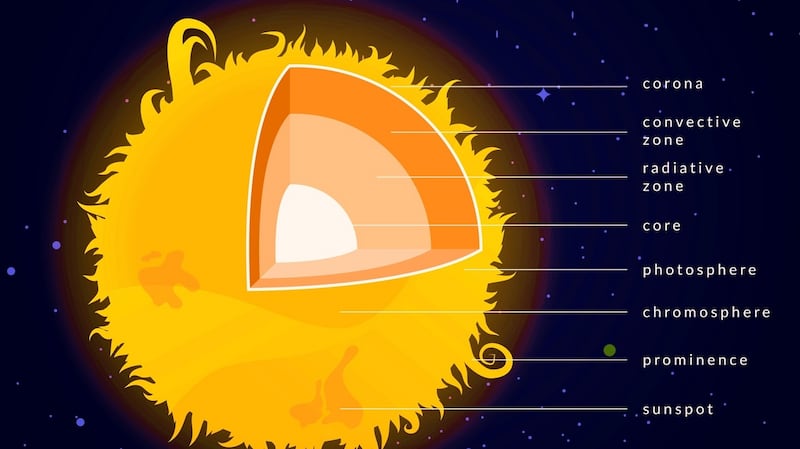Our sun sits at the centre of our solar system orbited by eight planets. It is an ordinary star, one of billions such stars orbiting the centre of our Milky Way galaxy. Its proximity to Earth (about eight light-minutes) is what makes the sun so special to us.
The sun is our only external source of heat and light and, in its absence, life on Earth would be impossible. But the effects of the sun are not entirely benign. For example, over-exposure to sunlight causes skin cancer, solar flares can seriously disrupt communications and power systems and, about five billion years from now the sun will incinerate Earth.
The average distance of the sun from Earth is 150 million km. The mass of the sun is 333,000 times Earth’s mass, its radius is 696,000km and volume could accommodate 1.3 million Earths. The sun is a big ball of gas, 74 per cent hydrogen (H), 25 per cent helium (He) and 1 per cent other elements. It is 25,000 light years away from the centre of the Milky Way galaxy.

The sun has no solid surface. The three main structural areas of the sun are the core, radiative zone and convective zone. The core comprises 25 per cent of the sun’s radius, radiative zone 45 per cent and convective zone 30 per cent. The sun has an atmosphere above its surface consisting successively of the photosphere, chromosphere and corona.
The temperature of the core exceeds 15 million degrees Kelvin. Gravity pulls all the mass inwards producing pressure high enough to force hydrogen atoms to fuse together to form helium atoms, which are slightly less massive (0.7 per cent less) than the hydrogen atoms that fuse together. This mass difference is converted to energy – according to Einstein’s equation E=MC2.
The energy is emitted from the sun in various forms of radiation; gamma rays, x-rays, ultraviolet light, visible light, infrared, microwaves and radio waves. The sun also emits a solar wind consisting largely of high-energy particles – protons, electrons, alpha particles and neutrinos.
These waves and particles hit Earth, providing energy for life, warming the planet and driving the weather and climate. The energy generated in the sun’s core is carried upwards through the radiative and convective zones and on again into the three atmospheric zones. Movement of gases in the sun’s interior causes intense magnetic fields. Dark areas called sunspots appear in pairs on the photosphere. sunspot activity is part of an 11-year solar cycle, with periods of maximum and minimum activity.
Violent sudden explosions occur sometimes in complex sunspot groups. These are called solar flares and are thought to be caused by sudden magnetic field changes. The flares are accompanied by the release of gas, electrons, visible and ultraviolet light and x-rays.
When this radiation reaches Earth, it reacts with Earth's magnetic field to cause the Aurora Borealis and the Aurora Australis. This radiation ionises the atmosphere and can prevent radiowave transmissions between satellites and earth and radio transmission on earth itself. Ionisation of the atmosphere induces currents in power lines and can cause power surges, overload power grids and precipitate blackouts.
One famous large solar flare – the Carrington Event – occurred in 1859. If such an event occurred today it would devastate satellite communications and ground installations and shut down Internet traffic for weeks or months. In the US alone, this would cost $7 billion per day.
There is historical evidence for occasional super flares, much larger than the Carrington Event. Such a flare solar would destroy data and all records could be lost – financial, medical etc. The threat posed by super flares is described by Jonathan O’Callaghan in Scientific American, December 2021. From now on it will be essential to closely monitor activity solar activity so satellite communications can be shut down prior to arrival of magnetic storms.
Our sun, has enough hydrogen fuel to burn for another five billion years. Then the core will contract under gravity and heat up. Temperatures will rise in the upper layers and the sun will expand rapidly transforming into a red giant star with a radius 100 times the present radius. The outer limits of the sun will lie close to Earth’s orbit. The Earth will plunge into the red giant and be vapourised. This is how humanity will end unless we leave Earth in the meantime to live elsewhere.
William Reville is an emeritus professor of biochemistry at UCC














